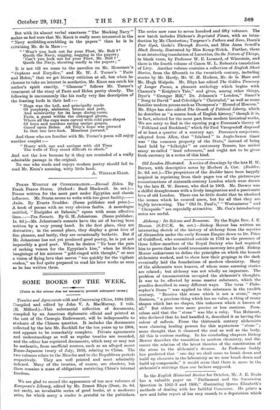Alchemy : Its Science and Romance. By the Right Rev.
J. E. Mercer. (S.P.C.K. 9s. net.)—Bishop Mercer has written an interesting sketch of the history of alchemy from the mystics of Alexandria under the early Roman Empire down to Dr. Price of Guildford, who committed suicide in 1783 in the presence of three fellow-members of the Royal Society who had required him to prove that he could transmute mercury into gold. Bishop Mercer endeavours to define the principles on which the honest alchemists worked, and to show how their gropings in the dark eventually laid the foundations of modem chemistry. Many of the alchemists were knaves, of whom some amusing stories are related ; but alchemy was not wholly an imposture. The problem of transmutation occupied the alchemist's thoughts. It was to be effected by some master substance, which the pundits described in many different ways. Tho term " Philo- sopher's Stone " was applied to this substance in the twelfth century. " Receive this stone which is not a stone," says Zosimus, " a precious thing which has no value, a thing of many shapes which has no shapes, this unknown which is known of all." But others were more precise or less cautious. Pam- eelsus said that the " stone " was like a ruby. Van Helmont, who declared that he had handled it, described it as having tho colour of saffron. From tho thirteenth century alchemists were claiming healing powers for this mysterious " stone " ; some thought that it cleansed the soul as well as the body. All this is curious reading. In his concluding chapters Bishop Mercer describes the transition to modern chemistry, and dis- cusses the relation of the latest theories of the constitution of the atom to the alchemist's dreams. As Professor Soddy has predicted that " one day we shall come to break down and build up elements in the laboratory as we now break down and build up compounds," it would seem that there is more in the alchemist's strivings than our fathers supposed.






































 Previous page
Previous page